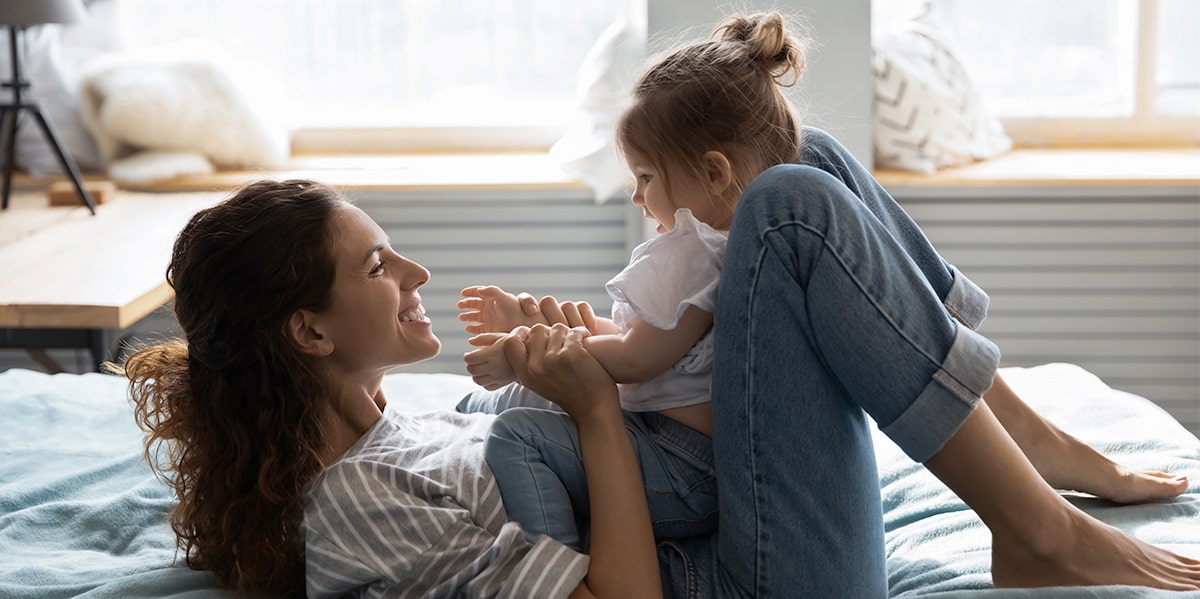My 18-Month-Old Daughter Knows What A Vulva Is
Kids have songs that help them learn their head and shoulders. Why not their butt and vulva?
 fizkes / Shutterstock
fizkes / Shutterstock I sit next to the tub as my 18-month-old daughter splashes around. She takes the plastic cup we keep in the bathroom and holds it under the faucet, letting it fill to the brim with water, then spill over. She dumps the full cup over her head and sputters, then giggles.
As I lather up her hair with shampoo, we begin our usual bath time routine.
“Where are your eyes?” I ask her. She pokes her eyelid and says, “AYE.”
Next, I ask, “And where are your toes?” She reaches down, grabs her big toes, and repeats, “Toes.”
“What about your nose?” I say. She bops her nose and says, “Know.”
We continue. “Where are your nipples?” I ask. She proudly slaps both sides of her chest with her palms and yells, “APPLES!”
And then, finally, “Where is your vulva?” She reaches down, touches her mons, and says in all seriousness, “BULBA.”
I give her a high-five and tell her how smart she is. Then she points to my own chest and asks, “Apple?” “Yes,” I tell her. “Mommy has nipples, too. You can nurse when you get out of the bath.”
Earlier in the day, we had been at her 18-month check-up with her pediatrician. After the physical exam was complete, the doctor said that the last thing she needed to check was my daughter’s vagina. So I told my toddler that we were going to show the doctor her vulva to make sure everything was OK.
My daughter tried to pull off her diaper, happy to show the doctor that she knew where her genitals were. The doctor was impressed. “Good job, momma,” she told me. It was the proudest moment of my very short parenting career.
While most parents don't know how to talk to toddlers about private parts, it’s intentional that I’ve been teaching my daughter the names of her body parts since the day she was born. During bath time and diaper changes, I’ve always made sure to name her parts and explain anytime I was touching her privates why I was doing it. “Mommy’s just making sure you’re clean so you don’t get a rash,” I tell her.
As a cisgender woman who has experienced numerous forms of sexual violence throughout my life, I want to protect my daughter from having to experience what I did. I know I’ll never be able to protect her fully, but I can equip her with certain tools that I didn’t have. One of those is the knowledge that her body belongs to her and that she has the right to dictate who touches it and where.
The other tool is the proper names for all her body parts, including her genitalia. Studies have shown that teaching kids the actual terms for their private parts — instead of cutesy nicknames — decreases their chances of being targeted by a sexual predator. Their words are their weapon, whether they know it or not.
The other thing that happens when we use pet names is that we send the message that there’s something inherently wrong or shameful about certain parts of our bodies. When words for particular body parts are “bad,” we perpetuate a shame around naked bodies, implying that they, too, are “bad.” But there’s nothing wrong or shameful about anyone’s genitalia.
These terms give them the language they need to talk about their body factually and removed from their gender identity, too. If my child ever tells me that they’re not a girl, the language we use to talk about their body parts won’t have to change. Parts are parts. Facts are facts.
Our kids have songs that help them learn their head, shoulders knees, and toes — why not their butt, vulva, vagina, penis, and testicles? I refuse to teach my daughter that she needs to be ashamed of her body or to speak of it in hushed tones. So we’ll keep having the kinds of open conversations we do.
When she follows me into the bathroom to sit on her potty while I sit on the toilet, we talk about what I’m doing. “I’m going pee out of my urethra and into my potty like you go pee-pee in your diaper,” I tell her.
She looks over, inquisitive. “Bulba?” “Yes, Mommy has a vulva, too.”
Of course, this isn’t to say that we don’t have boundaries. I want her to know that she has nothing to hide when it comes to her body, but that there are certain times and places where exposing herself is appropriate, like in the bathroom. Or the other day, when I asked her not to play with her vulva at the table, explaining that she could go to her room if she wanted to do that. No shame, no judgment, just facts.
So, yes, my toddler might walk up to you and tell you that she has a vulva. And if she does, you should respond the way that I do. “Yes, you do have a vulva! It’s in your diaper.” Because that’s the truth, and there’s nothing wrong with the truth.
Britni de la Cretaz is a freelance writer whose work focuses on sports, gender, culture, and queerness. Their writing is a mix between reported journalism and creative nonfiction, and they teach writing classes at GrubStreet.
